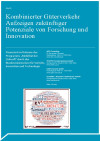KV-FTI – Combined freight traffic – revealing the future potentials of research and innovation
Short Description
Starting point / motivation
Previous innovations in CT have focused much on the development of new transhipment technologies. These innovations were very expensive and resulted in the medium term partly to a further increase in the cost of the supply chain.
The (partly) absence of fixed timetables and the organizational separation of CT and other train relevant products such as single wagonload services can be seen as a problem. The container shortage in Europe led to further extensive use of semitrailers (SAL). In order to be incorporated into the CT chain it would have to be lifted by crane trailer.
A far more efficient approach to RTI (research, technology, innovation) policy are tools for efficient redesign of the transport and business processes, the compatibility of interfaces (with orientation towards homogenization and standardization) for the individual actors and an adapted technological development of intermodal transport containers (containers, SAL, WAB) that builds on the existing infrastructures to deliver.
Contents and goals
In summary, the focus of this study can be seen as follows:
- comprehensive approach with a focus on organizational innovation
- merging of business and economic aspects and
- increasing efficiency through targeted introduction of RTI's existing infrastructure
- The goal of the investigation was to develop a medium-term RTI catalogue for Combined Transport.
Methods
In order to achieve the study's goal, a matrix of topics was elaborated with the stakeholders of the CT industry, which was mainly divided into two areas: "Hardware" and "Software". A high innovation potential was identified in the area of "Hardware", both in terms of lightweight construction (waggons and containers) and in terms of low-noise developments. With regard to containers, a trend towards "intelligent" containers can be ascertained. The increased integration of semi-trailers (which cannot be lifted by crane) into CT is also categorised as especially relevant.
Results and Conclusions
New and innovative services are crystallising as a main point of focus for the existing potentials across the entire ICT area, the so-called "Software". Above all, data management, Open Data concepts as well as the use of energy self-sufficient telematics systems for localisation and status monitoring could deliver a boost to innovation here. The general thrust is the possibility of planning and controlling right along the supply chain. CT solutions should above all be developed together with the terminals.
Publications
KV-FTI - Combined freight traffic - revealing the future potentials of research and innovation

Combined transport (CT) is an environmentally sensible and politically desired traffic, which is struggling with cost problems due to complicated supply chains. Previous innovations in CT have focused much on the development of new transhipment technologies. These innovations were very expensive and resulted in the medium term partly to a further increase in the cost of the supply chain. The intention of this study includes a redesign of the transport and business processes, the compatibility of interfaces (with orientation towards homogenization and standardization) for the individual actors and an adapted technological development of intermodal transport containers (containers, SAL, WAB).
06/2014
DI Alexander Chloupek (ABC Consulting)
Publisher: BMVIT
German, 50 Seiten
Publication Downloads
Project Partners
Project management
DI. Alexander Chloupek, ABC Consulting
Project partners
- Mag. Bernhard Fürst, TRAFFIX Verkehrsplanung GmbH
- Dipl. Wirtschaftsing. (FH) Horst Gamperl, GAHO-Consult GmbH
- Dr. Herbert Peherstorfer, CombiNet - Netzwerk Kombinierter Verkehr
Contact Address
ABC Consulting
DI. Alexander Chloupek
Tel.: +43 (1) 545-84-30
E-mail: abc@abc-consulting.at
